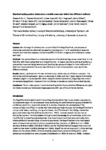Standard setting anchor statements: a double cross-over trial of two different methods.
| dc.contributor.author | Burr, Steven | |
| dc.contributor.author | Martin, T | |
| dc.contributor.author | Edwards, James | |
| dc.contributor.author | Ferguson, C | |
| dc.contributor.author | Gilbert, Kerry | |
| dc.contributor.author | Gray, C | |
| dc.contributor.author | Hill, A | |
| dc.contributor.author | Hosking, J | |
| dc.contributor.author | Johnstone, K | |
| dc.contributor.author | Kisielewska, J | |
| dc.contributor.author | Milsom, C | |
| dc.contributor.author | Moyes, S | |
| dc.contributor.author | Rigby-Jones, A | |
| dc.contributor.author | Robinson, Iain | |
| dc.contributor.author | Toms, Nick | |
| dc.contributor.author | Watson, Helen | |
| dc.contributor.author | Zahra, Daniel | |
| dc.date.accessioned | 2021-02-03T15:48:22Z | |
| dc.date.issued | 2021-02-03 | |
| dc.identifier.issn | 2312-7996 | |
| dc.identifier.issn | 2312-7996 | |
| dc.identifier.uri | http://hdl.handle.net/10026.1/16840 | |
| dc.description.abstract |
Context: We challenge the philosophical acceptability of the Angoff method, and propose an alternative method of standard setting based on how important it is for candidates to know the material each test item assesses, and not how difficult it is for a subgroup of candidates to answer each item. Methods: The practicalities of an alternative method of standard setting are evaluated here, for the first time, with direct comparison to an Angoff method. To negate bias due to any leading effects, a prospective cross-over design was adopted involving two groups of judges (n=7 and n=8), both of which set the standards for the same two 100 item multiple choice question tests, by the two different methods. Results: Overall, we found that the two methods took a similar amount of time to complete. The alternative method produced a higher cut-score (by 12-14%), and had a higher degree of variability between judges' cut-scores (by 5%). When using the alternative method, judges reported a small, but statistically significant, increase in their confidence to decide accurately the standard (by 3%). Conclusion: This is a new approach to standard setting where the quantitative differences are slight, but there are clear qualitative advantages associated with use of the alternative method. | |
| dc.format.extent | 1-13 | |
| dc.language.iso | en | |
| dc.publisher | Association for Medical Education in Europe | |
| dc.title | Standard setting anchor statements: a double cross-over trial of two different methods. | |
| dc.type | journal-article | |
| dc.type | Preprint | |
| plymouth.issue | 1:32 | |
| plymouth.volume | 10 | |
| plymouth.publisher-url | https://www.mededpublish.org/manuscripts/3529 | |
| plymouth.publication-status | Published online | |
| plymouth.journal | MedEdPublish | |
| dc.identifier.doi | 10.15694/mep.2021.000032.1 | |
| plymouth.organisational-group | /Plymouth | |
| plymouth.organisational-group | /Plymouth/Faculty of Health | |
| plymouth.organisational-group | /Plymouth/Faculty of Health/Peninsula Medical School | |
| plymouth.organisational-group | /Plymouth/REF 2021 Researchers by UoA | |
| plymouth.organisational-group | /Plymouth/REF 2021 Researchers by UoA/UoA03 Allied Health Professions, Dentistry, Nursing and Pharmacy | |
| plymouth.organisational-group | /Plymouth/Research Groups | |
| plymouth.organisational-group | /Plymouth/Research Groups/Institute of Translational and Stratified Medicine (ITSMED) | |
| plymouth.organisational-group | /Plymouth/Research Groups/Institute of Translational and Stratified Medicine (ITSMED)/CBR | |
| plymouth.organisational-group | /Plymouth/Research Groups/Plymouth Institute of Health and Care Research (PIHR) | |
| plymouth.organisational-group | /Plymouth/Users by role | |
| plymouth.organisational-group | /Plymouth/Users by role/Academics | |
| dcterms.dateAccepted | 2021-02-03 | |
| dc.rights.embargodate | 2021-2-5 | |
| dc.identifier.eissn | 2312-7996 | |
| dc.rights.embargoperiod | Not known | |
| rioxxterms.versionofrecord | 10.15694/mep.2021.000032.1 | |
| rioxxterms.licenseref.uri | http://www.rioxx.net/licenses/all-rights-reserved | |
| rioxxterms.licenseref.startdate | 2021-02-03 | |
| rioxxterms.type | Journal Article/Review |


